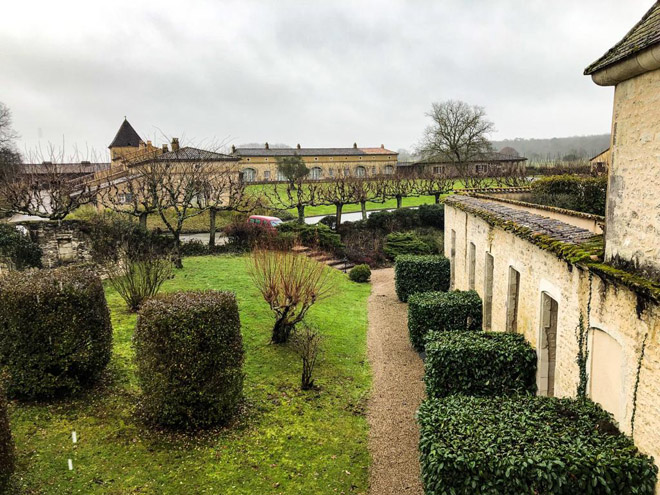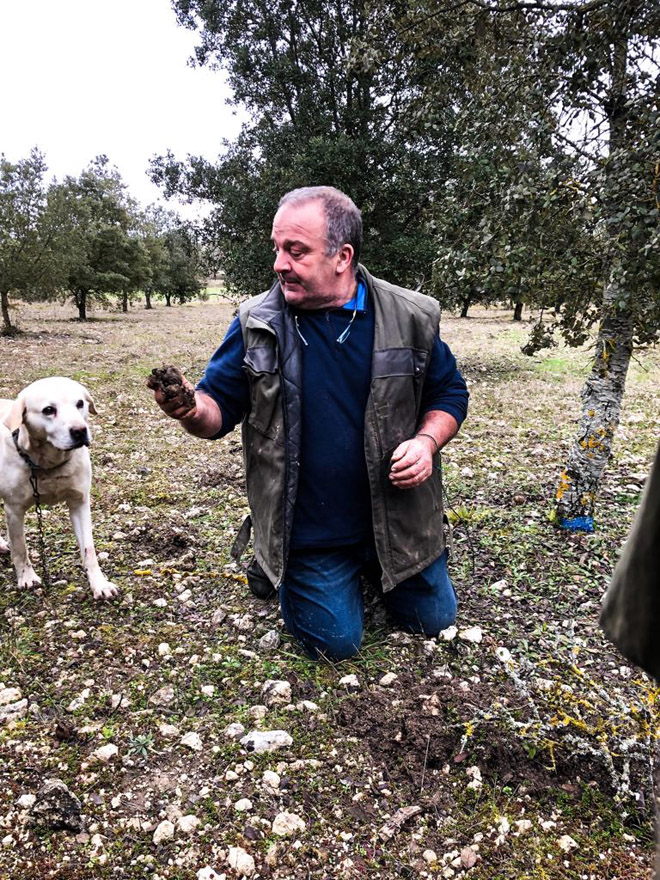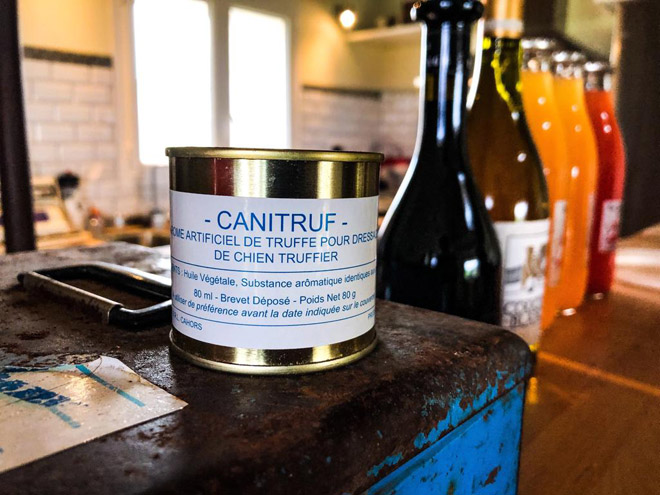The Ultimate Chopard Lifestyle featuring Château Monestier La Tour
A 3 day trip to Bordeaux encompassing Château Monestier La Tour, truffle hunting and biodynamic wine introduces the editor to the ultimate Chopard lifestyle
- An epic morning view of the golf course and lake where the Ryder Cup was once held. Photography: Jonathan Ho
- A foundation stone marking the Chateau grounds. Photography: Jonathan Ho
- Chateau des Vigiers as seen from the author’s suite. Photography: Jonathan Ho
A 70 minute ride away from Bordeaux airport lies the Château des Vigiers, a luxurious 16th century, golf-hotel-spa located on a sprawling estate situated between Bergerac and Saint-Emilion. The 25 rooms of the sumptuous Château des Vigiers conveys old school charm reminiscent of classic French living during the Age of the Renaissance. Arriving in the midst of winter, the irrepressible charm of the decadent French Château even if its undeniable beauty was not. I hear the luxury Château hotel is lovely in the spring, however, having checked-in with an overcast, wintery sky, only photos found online vindicate that belief.
For two days, the Château des Vigiers was a reminder of the Ancien Régime, where guests are pampered like classical aristocrats of the 18th century during the Bourbon dynasties. Le Spa located within the grounds of the estate is situated within the old wine making complex of Vigiers. Run by Sothys, it is the ideal place to relax, unwind and be treated with the wellness expertise of the region’s top masseuses and of course, the soin excellence secrets by Sothys – a unique blend of herbs and cosmetic ingredients combined with a unique treatment, for an unforgettable experience in a subtly perfumed atmosphere. After 13 hours of travels, it’s perhaps best to avail yourself of the Rituel visage et corps – a completely sensuous and restful 150 minute face and body ritual designed for “pour un soin complet et une detente maximale” – head to toe well being.

A charming, old school key and tassel set up for room access as opposed to the more contemporary, magnetic card access system in many hotels today. Photography: Jonathan Ho
Editor’s Travels: The Ultimate Chopard Lifestyle featuring Château des Vigiers, Truffle Hunting and Mr. Scheufele’s Château Monestier La Tour
After, hasten your long haul recovery with an exquisite dining experience at gourmet restaurant Les Fresques, a Michelin starred dinner served with a sublime view of the moonlit lake and the 27-hole golf course grounds; and our welcome dinner courtesy of Chopard, on the eve of a preview of their Baselworld novelties. Yet, arriving as we did, in the midst of winter, the sophistication and elegance of Château des Vigiers remained undimmed by the chilly winds and skeletal trees.
From this chateau, including from the rooms, you will have a breathtaking view of the Vigiers estate and park with its lake and the 27-hole Golf des Vigiers.
- Truffle hunting as led by Mr. Scheufele and Mr. Bonati. Photography: Jonathan Ho
- Bingo! Our doggo spots a truffle in the rough. Photography: Jonathan Ho
- Who’s a good boy? You are. Photography: Jonathan Ho
- The author and photographer, Jonathan Ho, in a “touch of tweed” as advised by Chopard
Remembering Bergerac – Truffle hunting
Gastronome Jean Anthelme Brillat-Savarin once famously nicknamed black truffles as “black diamonds”. Indeed, standing in the muddied grounds somewhere between Bordeaux and Bergerac, in southwestern France, it seemed little apparent that such high-value culinary elevating morsels were to be scavenged. In fact, the infamous Marquis de Sade is said to be enamoured of its aphrodisiac properties. Scientifically, a study of volunteers exposed to truffles were given photos of potential sexual partners and the subjects were all rated higher on attractiveness than the control group. With potent qualities such as these, it’s little wonder that there’s money to be made with truffles, but like all good things, these fungi don’t just simply grow under trees.
Led by Karl-Friederich Scheufele, co-President of Chopard, and Mr. Bonati, a truffle cultivator, a truffle hunting party of LUC aficionados and watch journalists gathered to listen how his farm was the pioneer for the region. Apparently, the horticulturist-proprietor had endured years of taunts until his growing success with cultivating black truffles encouraged his neighbours to attempt to grow the fickle ectomycorrhizal fungi.

Oaklings being nurtured to create the most encouraging environment for truffles to growth. Photography: Jonathan Ho
“if you want truffles plant acorns.” – French farmer Joseph Talon, 19th century
Truffles: roots of pleasure
The valuable fungi grows on the wealth of nutrients provided by roots of their host oak trees. These “hosts” inevitably transfer nutrients while the fungus help to capture soil minerals and water, hence, the relationship between truffles and oak isn’t parasitical but mutually beneficial – the complexity of this relationship is that if the tree alone is able to easily obtain these mineral nutrients and water, it ceases to depend on the fungus, so this can be moved easily by other fungi competitors always on the lookout, hence, it becomes important for truffle cultivators like Bonati to manage the soil conditions and environment which favour both the normal development of the trees by themselves in addition to the “black diamonds”.

Truffle hunting used the sensitive nose of pigs and boars to seek out high value mushrooms. Photography: Jonathan Ho
This method considered traditional crop of acorns that fall under oak trees that produce truffles and planting of new plots. Subsequently there were changes that were based on letting these acorns germinate under the trees and seedlings were transplanted new. The principle is that the seedlings were germinated under the oak trees naturally infected from truffle spores present and the same mycorrhizal truffle associated with the host tree, so these plants were new mycorrhizal and truffle producing then be planted after years (8 to 10). With this method was reached several thousand hectares in France, mostly coincided with the phylloxera invasion (in Vineyards), where many of these vineyards extracted, were replaced by plantations of truffle trees.
That said, while the “general rules of thumb” for cultivating truffles are understood, the intricacies and the thousands of bio-diverse organisms which interact to support the growth and development of this uncommon mushroom is significantly complex and worst of all, nigh uncontrollable from a genetic and environmental standpoint. Suffice it to say, the fruiting aside, the very nature of truffles means that you don’t just harvest it from the ground, one needs to hunt. Thankfully, the reproductive strategy of black truffles and its attractive qualities means that emits an aroma which naturally attracts pigs or boars, elderly virgins (if the 18th century myth is to be believed), and of course, sufficiently trained canine companions.
- Dogs are being increasingly used for truffle hunting in place of pigs because they’re more obedient. Artificial truffle is placed on the teats of the mommy-dog so the puppies can get used to the aroma and develop an association. Photography: Jonathan Ho
- The pups are bred and raised on the farm itself. Photography: Jonathan Ho
It begins to dawn, that there are corollaries between fine Chopard watchmaking and the intricate art of truffle cultivation and its companion activity of the viticultural nature.
Biodynamic WIne at Scheufele’s Château Monestier La Tour and Chopard LUC’s sustainable watchmaking philosophy
Château Monestier La Tour dates back to the 13th century. The ramparts and portcullis are perhaps the only indication that the property was originally envisioned as a defensive garrison to guard the valley during that period. Nevertheless, during Château Monestier La Tour has been home to noblemen since its foundations, beginning with the Pellegrue family and then from 1614 to 1925, the Verthamons, a bourgeois family originating from Limoges, as well as the Brugieres, the Bourdichons and the Masmontet-Fonpeyrine families. Suffice it to say, when Château Monestier La Tour became the property of La Galerie des Arts du Vin France in January 2012, the estate returned to nobility of a more contemporary family – the Scheufele family.

The Chopard LUC Grand Cru collection was inspired by the wine barrels at Chateau Monestier La Tour
From Fairmined gold to ethical gold, the former being a process where the provenance of gold is managed end-to-end by Louis Ulysse Chopard manufacture, the former is a chain of suppliers who practice ethics in gold mining but whose process is not directly overseen by Chopard. Mr. Scheufele safeguards not so much the geography of France but veritably, the moral, philosophical and indeed, the very future of humanity.
Responsibility and ethics are values enshrined at the heart of Chopard’s philosophy. As a vertically-integrated independent company, all of gold alloys in-house since 1978. This closed loop-model allows the Manufacture to recycle as much as 70% of production waste, thereby reducing dependence on freshly mined gold at both production facilities in Switzerland (Geneva and Fleurier) and Germany (Pforzheim); As part of “The Journey to Sustainable Luxury”, Chopard supports responsible artisanal gold mining cooperatives in Latin America to help them obtain Fairmined Certification. The Fairmined Standard requires ASM organizations to demonstrate that strict requirements for working conditions (including the prohibition of child labor), social development criteria and environmental protection are maintained during the mining process. Hence, the Fairmined Standard ensures that miners are provided with a stable route to market and a fair price for the gold which they produce. The premium which miners receive (in addition to the market price) is used to improve living and working conditions for artisanal miners and their communities, helping to contribute to the construction and strengthening of empowered mining communities in a sustainable manner.

Fairmined Gold at Chopard expresses Mr. Scheufele’s philosophy and just one area of his life. This outlook extends to all his other endeavours including viticulture.
Biodynamic Winemaking and Sustainable Watchmaking
This corollary extends to Château Monestier La Tour. Since their stewardship in 2012, the vineyard has been subject of an ambitious restructuring programme to focus viticulture methodology on biodynamism. Overseen by Derenoncourt Consultants, Mr. Scheufele extends his watchmaking philosophy into winemaking with practices and wines made with respect for nature, anchored in their terroir and endowed with a balance of depth, fruitiness, elegance, and importantly, sustainability.
- Biodynamic wine making follows astrology and the Earth’s natural lunar cycles. Photography: Jonathan Ho
- No chemicals are used. In its place, all natural herbs and flora. Photography: Jonathan Ho
Biodynamic wine is made using only natural materials, soils, and composts are used to sustain the vineyard. Ecologically speaking, the biodynamic process simply respects how wine would have been made before the advent of the industrial process and high production techniques; it assumes that by reintroducing a range of animals from horses to sheep live as they did in the environment, thus fertilising it (as opposed to artificially fertilising the ground with chemicals), a rich, fertile environment creates a better vine. Because, biodynamic wine is made with all processes from soil to harvest as one entity, the biodynamic calendar is also another integral component. These farming practices are managed by a biodynamic calendar, while not entirely scientific, It breaks all the tasks associated with farming into four periods each associated with it that are reflective of Earth’s four classical elements. Fruit days are meant for harvesting, leaf days for watering, root days for pruning. On flower days, the vineyard is simply left to ‘flower’. Biodynamic farming seeks sustainability, or leaving the land in as good or better shape as they found it for future generations. Unlike organic farms, biodynamic farming takes other factors into account when farming, such as the lunar calendar and astrology. Hence, it takes the world and the life it supports in its entirety, not just the grapes. At Chopard, the world at large is its stakeholder, not just the timepieces and the people who buy them.

The Chateau Monestier La Tour
Dynamic viticulture helps preserve the biodiversity and natural balance of Château Monestier La Tour. In a transition of period of three years, the vineyard was finally certified organic by 2017, further extending the corollary with watchmaking, in 2017, Chopard became the single largest buyer of Fairmined gold, using the gold produced by these communities in order to create responsible Haute Joaillerie Collections (including the Green Carpet Collection), and complication L.U.C timepieces. At its core, the philosophy at the heart of Mr. Scheufele’s endeavours points to the convergence of the human hand and the human heart, an exercise of artisanship more precious than gold or the objets d’art they produce, it’s an offering of love and a fellowship of all mankind.














